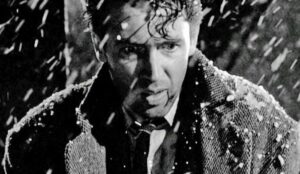 If you’ve been a follower of my blog for a while, you probably know that my favorite movie is It’s a Wonderful Life, the timeless classic from Director Frank Capra. I watch the film almost every year, usually around the holidays, and it hits me in the feelings every time I watch it.
If you’ve been a follower of my blog for a while, you probably know that my favorite movie is It’s a Wonderful Life, the timeless classic from Director Frank Capra. I watch the film almost every year, usually around the holidays, and it hits me in the feelings every time I watch it.
There’s a little known story surrounding the film and it’s star, Jimmy Stewart, that I wanted to share. It speaks to the type of man Stewart was, as well as the sacrifices made by the “Greatest Generation.”
In 1941, Stewart won the Academy Award for his performance in The Philadelphia Story. At the age of 33, Stewart was one of Hollywood’s brightest stars. Yet, when the United States entered World War II, he was one of the first big-name celebrities to join the war effort. He enlisted in the U.S. Army, and as a private pilot, became an Army Air Corp aviator (This was in the days before the Air Force was a separate branch of the military).
In 1942, Stewart was commissioned a 2nd Lieutenant, and, as a celebrity, was assigned to star in recruiting films, attend rallies, and train younger pilots. The assignment did not sit well with Stewart, who wanted to fly combat missions, not remain stateside. He pushed for a transfer to Europe, but was initially rebuked by his commanding officers. Stewart persisted, and in 1944, not only did he get his wish to enter the fight, but was also promoted to Captain.
For the next 18 months, Stewart flew B-24 Liberator bombers over Germany from his base in England. His commanding officers tried to arrange it so Stewart wouldn’t fly over enemy territory, but Stewart wasn’t having it. Not only did he buck his superiors’ wishes, but as a Captain, he assigned himself to as many combat missions as possible. By the end of the war, Stewart, who completed a total of 20 combat missions, was one of the most respected and highly decorated pilots in his unit.
Unfortunately, Stewart’s service came at a high price. By the end of the war, he was grounded with, what at the time was called being “flak happy.” Today, we’d call his condition post traumatic stress disorder (PTSD).
Stewart returned to the United States in 1945 a changed man. He had lost weight and was unusually thin, he suffered from depression, and had trouble sleeping. When he did sleep, he had horrible nightmares of planes exploding and men dying. Stewart had seen his share of planes shot out of the air and men killed. In one mission alone, his unit lost 13 planes and more than 130 men were killed. Stewart knew many of those men.
Stewart had trouble focusing and refused to discuss his war experience. He was a mess, and his acting career was all but over. A biographer of Stewart wrote, “Every decision he made [during the war] was going to preserve life or cost lives. He took back to Hollywood all the stress that he had built up.” The war was over, but for Stewart, he was fighting the aftermath of his time in combat.
In 1946, Stewart was asked to play a suicidal man in a small film entitled It’s a Wonderful Life, opposite actress Donna Reed. In the scenes where Stewart’s character, George Bailey’s life was unraveling, both actors and crew members recognized that Stewart wasn’t acting. He was reliving the horror of his time in the war.
Years later, Stewart admitted that his time filming It’s a Wonderful Life was therapeutic for him and helped him address some of the demons that were eating at him. Of course, he went on to become one of the most accomplished and popular actors in American film history.
Unfortunately, Its a Wonderful Life was panned by critics and largely shunned by filmgoers. The film did so poorly at the box office that director Frank Capra had trouble getting the money to make other films. The movie was largely forgotten, and in 1974, due to a clerical error, Republic Pictures, owner of the rights to the film, lost its copyright. This allowed television stations to show It’s a Wonderful Life without paying royalties to Republic. The film became a staple around the holidays and gained a popularity it had never before experienced.
A Supreme Court case involving one of Stewart’s other films, Rear Window, (Stewart v Abend) allowed Republic to regain its copyright, and they subsequently signed an exclusive licensing agreement with NBC to show It’s a Wonderful Life on TV. In recent years, more and more theaters are showing the film on the big screen during the holidays.
Stewart died in 1997, but not before seeing It’s a Wonderful Life become one of the most popular of his films and one of the most beloved holiday movies in America. And despite the PTSD he suffered and the difficulties he encountered once he returned home, Stewart did not immediately leave the military. Instead, following the war, he joined the United States Air Force Reserve and was eventually promoted to the rank of Brigadier General. He finally retired in 1968, twenty-seven years after first enlisting. During his military service, Stewart was awarded two Distinguished Flying Crosses, four Air Medals with three bronze oak leaf clusters, the French Croix de Guerre with bronze palm, as well as several other commendations. In 1985, he received the Presidential Medal of Freedom, the nation’s highest civilian honor.
Jimmy Stewart was among the best of his generation; a generation that fought authoritarianism and defended freedom. And It’s a Wonderful Life went on to become a classic, beloved film, showcasing what made America a beacon of light for the world in the 1940s, and today, shows us what is still possible if we’re willing to work for it.

Great blog about the actor’s story in one of my favorite movies! I watch it every year either on Christmas Eve or a few days earlier. My Dad, who served in WWII and also worked at the State Movie Theater in Rockford, introduced this movie to me when I was in college. To my surprise, I became emotional at the end…and still do. My favorite quote is from Clarence: “Remember, no man is a failure who has friends.”
Happy holidays and happy movie watching!